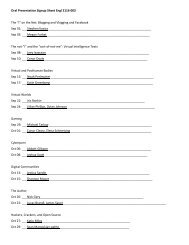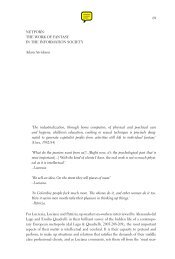Nakamura, Digitizing Race, Introduction, chapter 5, Epilogue
Nakamura, Digitizing Race, Introduction, chapter 5, Epilogue
Nakamura, Digitizing Race, Introduction, chapter 5, Epilogue
Create successful ePaper yourself
Turn your PDF publications into a flip-book with our unique Google optimized e-Paper software.
38 “Ramadan Is Almoast Here!”<br />
of user-produced buddy icons in Instant Messenger applications on the Internet;<br />
these feature visual images of the databody as an instrument used simultaneously<br />
for both socializing and entertainment, since in the case of IM,<br />
socializing is entertainment. I wish to repurpose some of the rightly pessimistic<br />
discourse of surveillance surrounding such things as electronic signatures<br />
with a more hopeful reading about minoritarian identity creation on<br />
IM. In particular, it is possible to find images of national, religious, linguistic,<br />
and sexual identities created by users as icons on IM: overtly gay, fundamentalist<br />
Muslim or Christian, Armenian, or Asian American visual images<br />
are easier to locate there than in other media forms, including other parts of<br />
the Internet, and are certainly not often seen in commercial games. The creation<br />
and use of these images have particular relevance to questions of freedom,<br />
diversity, and racial equality online considering the use of dataveillance<br />
technologies to track precisely those groups—fundamentalist Muslims<br />
(but not Christians) and immigrants—who are least likely to be fairly or<br />
self-represented in American mainstream visual culture. In creating and using<br />
these very personal and amateur digital signatures of identity, IM users literally<br />
build themselves as subjects of interactivity.<br />
Synchronous or real-time networked textual interaction, from one person<br />
to another person, has existed since the early command-line interface<br />
days of the Internet. Unix applications like “chat” and “phone” remediated<br />
the most familiar person-to-person form of communication known by most<br />
people—the telephone—but with little in the way of graphics; clients<br />
could regulate the flow of text streaming down a screen so that it didn’t appear<br />
radically fragmented and thus was more readable, but it really was a textonly<br />
environment, with the user’s only intervention into it being the size and<br />
perhaps style of font displayed. These applications also ran in the background<br />
of others and could thus be overlooked by a busy user. Instant Messenger,<br />
while it shares these basic qualities with “talk” and “phone,” remediates an<br />
early application called “write” in that it pops up or supersedes other open<br />
windows in graphical user interfaces; it is meant to intrude on the visual field<br />
of the user, and though it can be demoted later, its use of alert sounds to signify<br />
the arrival of an instant message makes it seem more immediate. Instant<br />
Messenger has its roots in ICQ, a text messaging application that became<br />
popular in 1996, and occupies a unique position in that it is in many ways a<br />
low-bandwidth, anachronistic technology despite its popularity, and one<br />
that defies academic prediction. As recently as 2001, new media theorists<br />
David Bolter and Richard Grusin and Per Persson seriously questioned text-





